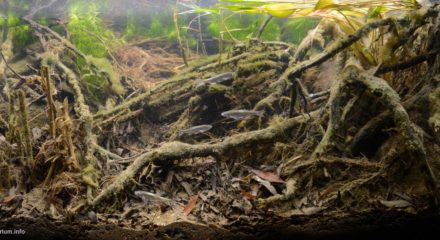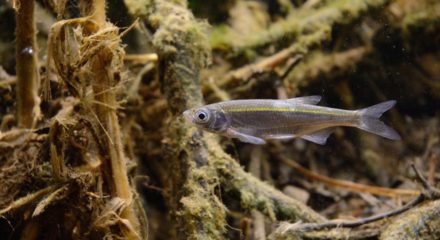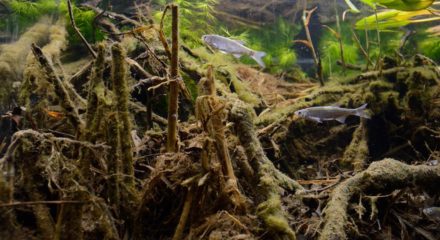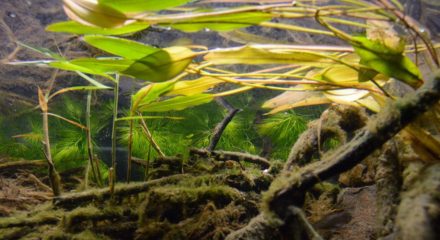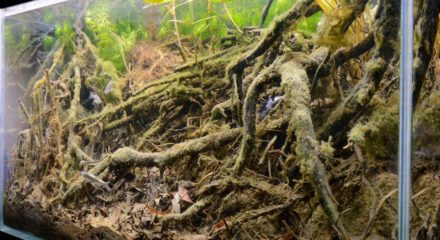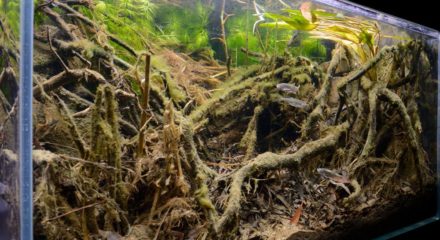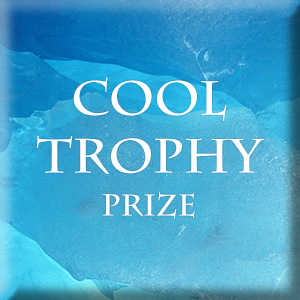 Kopački rit, Croatia, east of vilage Kopačevo, swamp area of Drava branch
Kopački rit, Croatia, east of vilage Kopačevo, swamp area of Drava branch
4th place in Biotope Aquarium Design Contest 2016
![]() Croatia. Stjepan Erdeljic
Croatia. Stjepan Erdeljic
Aquarium Volume: 182 L
Fish and invertebrates: Leucaspius delineatus
Plants list: Ceratophyllum demersum, Potamogeton nodosus, Phragmites australis
Biotope description: Kopački rit Nature Park, also called the European Amazon, is situated in the central part of the Danube floodplain, between two important European rivers, the Drava and the Danube. It became a protected area in 1967 due to its values as a rare ecosystem, its rich biodiversity and important ecological values. The whole surface of the Park lies on 23.891 ha of which 7.143 ha are under higher protection being a Special Zoological Reserve. Forty-four freshwater cold-water fish species have been recorded in Kopački rit but it is assumed that the area could have even sixty different species. Even nine species were brought into the Park while the other thirty-five are autochthonous species.
Fish and invertebrates: Leucaspius delineatus
Plants list: Ceratophyllum demersum, Potamogeton nodosus, Phragmites australis
Biotope description: Kopački rit Nature Park, also called the European Amazon, is situated in the central part of the Danube floodplain, between two important European rivers, the Drava and the Danube. It became a protected area in 1967 due to its values as a rare ecosystem, its rich biodiversity and important ecological values. The whole surface of the Park lies on 23.891 ha of which 7.143 ha are under higher protection being a Special Zoological Reserve. Forty-four freshwater cold-water fish species have been recorded in Kopački rit but it is assumed that the area could have even sixty different species. Even nine species were brought into the Park while the other thirty-five are autochthonous species.
Photo Gallery
Comments of the members of the jury of Biotope Aquarium Design Contest 2016

Beatifuly executed, this tank is showing how coldwater biotopes can look amazing, even with „dull“ looking fish. Main things where this tank lost its perfect points were sustainability – a lot of biological material that is hard to control and acces during maintenance, and description – not elaborated enough.

This is a brilliant biotope aquarium on so many levels – looks, accuracy, rarity of species, and the fact that it is a coldwater biotope, which itself is rare. The densely matted background making its way across the base and right into the foreground imitates a vegetation laden bank, complete with a very realistic layer of detritus covering everything, yet clear water! The subtle beauty of the Leucaspius complements the scene and they and the aquascape combine to create what looks like a real slice of nature. Very well done. My favourite biotope in this competition.

This tank would be absolutely the best – the “dirt” on the decorations looks really amazing. The only problem, though, is that there are too many decorations. Almost the entire tank is filled with them, leaving not much space for very active fish to swim. Also, such large amount of decaying matter will cause a biological disaster if kept in the aquarium for a longer time.

It is another realistic copy of a biotope, which I had seen many times in nature. For long-term functioning there is too much organic matter in it. There could be more species of fish, too (not predators).

I tell you, I have swam in so many rivers that look exactly like this biotope aquarium! It is an exact replica of a river bank. I hope, some day, I can sit in front of an aquarium and see this biotoper create one of these in front of me. I was upset to see such a short biotope description, I wanted to know more about this creation.When you are looking at something that looks exactly like nature it is easy to get caught in the “how did he create this biotope aquarium?” Well stop doing that, you are looking at it in the wrong way. Just sit back and enjoy it. It’s incredibly amazing! This is a super biotope aquarium, probably one of the best I have seen.

The hyper-realism of this masterpiece is what made me rate it among my top picks. I only wish it had included one or two more species of fish, since this is the “European Amazon” with up to 60 species of fish! A marginal zone is recreated here with incredible attention to detail. Shaggy, algae-encrusted roots eroding from a muddy bank interspersed with broken, disintegrating reeds give a real feeling of seasons of regrowth. Accumulated leaves layered with mud and organic debris accentuate this sense of time. The leaves of marginal plants extending from the shore in the background and the steeply sloping bank extending almost to the surface increase the illusion of depth. The whole thing looks as though a chunk of the river were teleported perfectly intact, with the fish apparently none the wiser. A spectacular example of what can be achieved with close attention to the original biotope and an uncompromising dedication to replicate it.
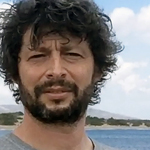
The aquarium is set up very well in terms of design. When the space is filled by 90%, there are all the classic proportions and the golden section is noticeable. The author has made an amazing accuracy, using a minimum of decorative elements. Often such a design with lots of branches continues above the surface of the water. I like that the composition does not exceed the water. On the bottom there are long narrow leaves. It may be willow or silverberry. These are the trees that often grow along the water bodies in our latitudes. Underwater landscape is copied accuartely. It seems that the author came to the river bank with a shovel, dug his favorite part of the bottom and put it into a glass box. I like the variety of aquatic organisms. I have long been thinking of belica as an object of aquarium design. What could be more simple than this silvery fish? And this is its charm. Belica can not often be found near the margin. But closer to the cold weather belica hides in the reeds. Taking into account that now it is autumn, that’s correct. Plants of northern latitudes die in aquaria in winter. On the other hand, they die in nature too. I think a lot of the entries will be similar to this one next year. Thank you for a tour to Kopački rit.

